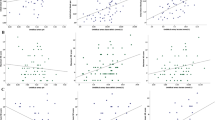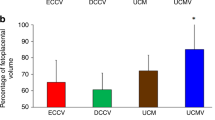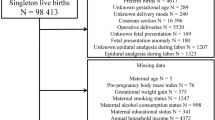Abstract
OBJECTIVE:
Apgar scores and cord blood gases (BG) and pH were compared between a group of babies with nuchal cords and a group without nuchal cords and uncomplicated deliveries.
STUDY DESIGN:
We collected umbilical arterial (UA) and umbilical venous (UV) blood samples from the placentas of term infants from both normal deliveries (NORM, n=29) and nuchal cords (NUCH, n=33). BG/pH and hematocrit were measured; base deficits and oxygen contents were calculated; and a member of the study assigned Apgar scores and demographic data were collected from the babies’ charts.
RESULTS:
Median Apgar scores in the NUCH babies at 1 and 5 minutes were 9 and 9 respectively, which did not differ from the NORM infants. The pH, PCO2, and oxygen content obtained from UV of the NUCH infants was not statistically different from the NORM. The pH and oxygen content of the NUCH UA was significantly lower than that of the NORM. The UA PCO2 in the NUCH was greater than the NORM. Veno-arterial (VA) differences (ΔVA) in pH and PCO2 of the NUCH infants were greater than that of the NORM.
CONCLUSION:
The Apgar score is not a sensitive indicator of acid-base changes in nuchal cord patients; UV samples alone may be misleading. UA must be sampled to detect the hypercapnia and diminished oxygen content that is a result of the nuchal cord.
This is a preview of subscription content, access via your institution
Access options
Subscribe to this journal
Receive 12 print issues and online access
$259.00 per year
only $21.58 per issue
Buy this article
- Purchase on Springer Link
- Instant access to full article PDF
Prices may be subject to local taxes which are calculated during checkout
Similar content being viewed by others
References
Casey BM, McIntire DB, Leveno KJ . The continuing value of the Apgar score for the assessment of newborn infants. N Engl J Med 2001;344:467–471.
Yeomans ER, Hauth JC, Gilstrap LC, Strickland DM . Umbilical cord pH PCO2, and bicarbonate following uncomplicated term vaginal deliveries. Am J Obstet Gynecol 1985;151:798–800.
Casey BM, Goldaber KG, McIntire DB, Leveno KJ . Outcomes among term infants when two-hour postnatal pH is compared with pH at delivery. Am J Obstet Gynecol 2001;184:447–450.
Low JA, Pickersgill H, Killen H, Derrick J . The prediction and prevention of intrapartum fetal asphyxia in term pregnancies. Am J Obstet Gynecol 2001;184:724–730.
West JB, Wagner PD . Pulmonary gas exchange. In: West JB, editor. Bioengineering Aspects of the Lung. New York (NY): Marcel Dekker; 1977. p. 363–366.
Nelson NM . Respiration and circulation before birth. In: Smith CA, Nelson NM, editors. Physiology of The Newborn Infant. Springfield: Charles C Thomas Press; 1976. p. 23.
Pomerance J . When cord gases do not reflect fetal condition. In: Pomerance J, editor. Interpreting Umbilical Cord Blood Gases. Pasadena: BNMG; 2004. p. 6.
Pomerance J . When cord gases do not reflect fetal condition. In: Pomerance J, editor. Interpreting Umbilical Cord Blood Gases. Pasadena: BNMG; 2004. p. 8–9.
Belai Y, Goodwin TM, Durand M, Greenspoon JS, Paul RH, Walther F . Umbilical arteriovenous PO2 and PCO2 differences and neonatal morbidity in term infants with severe acidosis. Am J Obstet Gynecol 1998;178:13:9.
Clapp JF, Lopez B, Simonean S . Nuchal cord and neurodevelopmental performance at 1 year. J Soc Gynecol Invest 1999;6:268–272.
Sornes T . Umbilical cord encirclements and fetal growth restriction. Obstet Gynecol 1995;86:725–728.
Weber T . The influence of cord complications on fetal pH, neonatal apgar score, and the acid base state and oxygenation of the umbilical artery and vein. J Perinatal Med 1981;9:134–139.
Waugh J, Johnson A, Farkas A . Analysis of cord blood gas at delivery: questionnaire study of practice in the United Kingdom. BMJ 2001;323:727.
Pomerance J . Umbilical cord blood gas casebook. J Perinatol 1997;17:503–505.
Author information
Authors and Affiliations
Rights and permissions
About this article
Cite this article
Martin, G., Green, R. & Holzman, I. Acidosis in Newborns with Nuchal Cords and Normal Apgar Scores. J Perinatol 25, 162–165 (2005). https://doi.org/10.1038/sj.jp.7211238
Published:
Issue Date:
DOI: https://doi.org/10.1038/sj.jp.7211238
This article is cited by
-
Adverse neonatal outcome and veno-arterial differences in umbilical cord blood pH (ΔpH) at birth: a population-based study of 108,629 newborns
BMC Pregnancy and Childbirth (2023)
-
Nuchal cord and its implications
Maternal Health, Neonatology and Perinatology (2017)
-
Correlation of fetal scalp blood sampling pH with neonatal outcome umbilical artery pH value
Archives of Gynecology and Obstetrics (2016)
-
Predictability of Fetal Doppler, Biophysical Profile, and Cardiotocography for Fetal Acidosis at Birth
Journal of Fetal Medicine (2014)
-
Is nuchal cord justified as a cause of obstetrician anxiety?
Archives of Gynecology and Obstetrics (2014)



